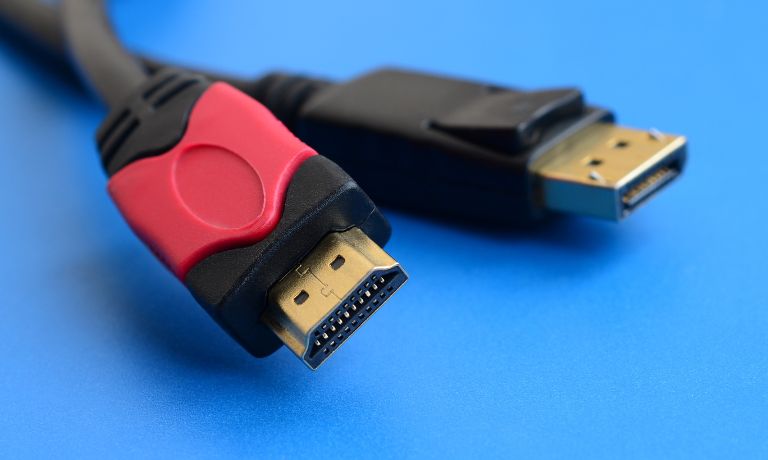A DisplayPort cable might look simple, but it plays a big role in how your monitor performs. Whether you’re gaming at 144Hz, editing 4K video, or connecting multiple displays, the right cable ensures a clear picture and smooth performance. Choosing the wrong one can cause flicker, lower refresh rates, or even a blank screen.
This guide explains what to look for when buying a DisplayPort cable – from version numbers and bandwidth to certification and build quality – so you can pick the right one for your setup.
What Is a DisplayPort Cable?

DisplayPort is a digital video and audio interface made for computers and monitors. It’s similar to HDMI, but it’s designed for higher data transfer speeds and better support for advanced display features. Most gaming monitors and professional displays use DisplayPort because it handles high refresh rates and resolutions more easily than HDMI.
A DisplayPort cable connects your graphics card (GPU) to your monitor, transferring video, audio, and sometimes even power. While all DisplayPort cables use the same connector shape, their internal quality and supported versions make a big difference.
Understanding DisplayPort Versions
DisplayPort has evolved through several versions, each improving bandwidth and capabilities. Knowing these helps you match the right cable to your display.
- DisplayPort 1.2
Introduced support for 4K at 60Hz and 1080p at very high frame rates. It’s still common in many mid-range monitors. - DisplayPort 1.4
This version increased bandwidth and added support for 4K at 144Hz and 8K at 60Hz using compression (DSC). It’s perfect for modern gaming monitors. - DisplayPort 2.0 and 2.1
The latest versions offer massive bandwidth – up to 80Gbps – and can handle 8K at 120Hz or multiple 4K monitors at once. They’re ideal for high-end or future-proof setups.
Keep in mind that both your GPU and monitor need to support the same DisplayPort version to get the full performance.
Cable Bandwidth and Resolution
Each DisplayPort version has a different bandwidth capacity. The higher the bandwidth, the more data the cable can carry – which means better support for high resolutions and refresh rates.
For example, if you have a 4K monitor with a 144Hz refresh rate, you’ll need at least a DisplayPort 1.4 cable that supports HBR3 bandwidth (32.4 Gbps). Using an older 1.2 cable might limit you to 60Hz or cause screen flicker.
Always match your cable’s version to your monitor’s resolution and refresh rate to avoid performance issues.
Cable Length and Build Quality
DisplayPort cables lose signal strength over long distances. A short, high-quality cable is always better. For most users, a cable under 2 meters (6 feet) keeps a strong, stable signal.
If you need a longer cable – for example, to connect to a wall-mounted monitor – look for active DisplayPort cables. These cables boost the signal, helping maintain image quality over longer runs.
Build quality also matters. Thick cables with good shielding prevent signal interference, and gold-plated connectors resist corrosion over time. A well-made cable lasts longer and performs more reliably.
Active vs Passive DisplayPort Cables
DisplayPort cables come in two main types: passive and active.
- Passive cables are simple and work well for short connections between your PC and monitor.
- Active cables include a small chip that amplifies the signal, useful for longer runs or when connecting through adapters or docks.
If your setup requires a long cable or involves multiple devices, active cables help maintain quality without dropping the signal.
Certified vs Generic Cables
Not all DisplayPort cables are created equal. Some cheap, generic options may claim to support 4K or 8K, but they often fail to meet official performance standards.
Look for VESA-certified cables. VESA (Video Electronics Standards Association) tests and approves cables that meet proper bandwidth and reliability standards. Certified cables display the DP Certified logo or come listed in VESA’s product database.
Choosing a certified cable helps avoid flicker, random blackouts, or connection drops, common issues with untested cables.
Choosing the Right Cable for Your Setup
Here’s a simple way to decide which cable to buy:
- 1080p or 1440p at 60–144Hz: DisplayPort 1.2 is more than enough.
- 4K gaming or HDR content: Go for DisplayPort 1.4 (HBR3 support).
- 8K or multi-monitor setups: DisplayPort 2.1 is your best choice for maximum future compatibility.
DisplayPort is backward compatible, meaning newer cables work with older devices, they just run at the older version’s limits.
Common Mistakes to Avoid
Many users buy cables labeled “8K” or “4K” without checking if they’re officially certified. Some of these are misleading or poorly made.
Avoid buying ultra-long cables unless they’re active, as signal loss increases with distance. Always make sure both your monitor and graphics card support the same DisplayPort version; otherwise, you won’t get full performance even with a premium cable.
Conclusion
Choosing the right DisplayPort cable isn’t just about picking the cheapest one, it’s about matching your setup’s needs. The version, length, and certification all affect display quality.
For most users, a short, VESA-certified DisplayPort 1.4 cable works perfectly for 4K and high refresh rate gaming. For future-proofing or 8K displays, DisplayPort 2.1 is the way to go.
A small investment in a good cable ensures your monitor performs at its best, with sharper images, smoother motion, and zero signal issues.
I’ve been into SEO and blogging for over 7 years. I help websites show up higher on search engines. I really enjoy writing helpful guides, especially about gaming and tech stuff.
